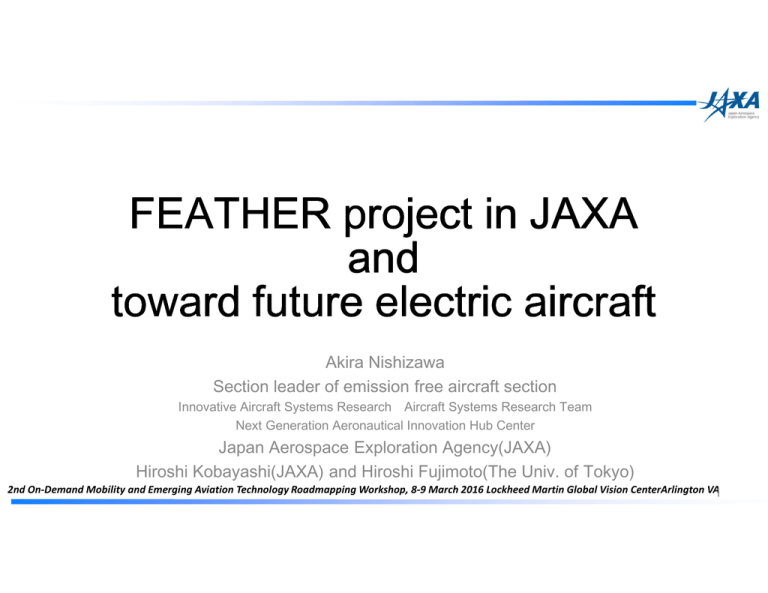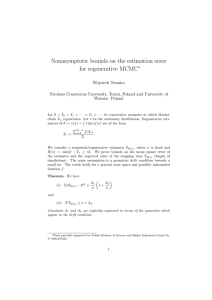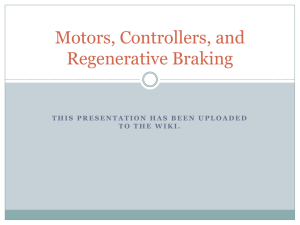FEATHER project in JAXA and toward future electric aircraft
advertisement

FEATHER project in JAXA and toward future electric aircraft Akira Nishizawa Section leader of emission free aircraft section Innovative Aircraft Systems Research Aircraft Systems Research Team Next Generation Aeronautical Innovation Hub Center Japan Aerospace Exploration Agency(JAXA) Hiroshi Kobayashi(JAXA) and Hiroshi Fujimoto(The Univ. of Tokyo) 2nd On-Demand Mobility and Emerging Aviation Technology Roadmapping Workshop, 8-9 March 2016 Lockheed Martin Global Vision CenterArlington VA1 Outline 1. Future Vision and Issues 2. FEATHER project 3. Toward future electric aircraft 2 1. Future Vision and Issues 1. 1 Future vision A 19th-Century Vision of the Year 2000 http://publicdomainreview.org/collections/france-in-the-year-2000-1899-1910/ 3 1. Future Vision and Issues 1. 2 Problems of Small Aircraft fee[US$/ASK]] Ticket fee[US$/ASK Higher Cost 1.0 Lower Safety Air Line Air carrier Regular fee 0.8 Air taxi & Commuter Discount fee General aviation 0.6 10.53 0.4 0.2 2.35 0.34 0.0 1 10 100 No. of seats Unit ticket fees for domestic flights (in JAPAN, 2014) 1000 16.57 The fatal accident rate of small aircraft is about 10X higher than that of large aircraft Number of fatal accidents per 1 million flight time (average during 1982-1999 in USA) Source: NTSB Aviation Accident Database 4 1. Future Vision and Issues 1.3 Major issues and solution Goal Popularization of General Aviation PAV, AirTaxi, ODM Issues Reduction of operating cost Current:3~5X higher than airliner Reduction of fatal accidents Current:10X higher than airliner Solution Electric JAXA aircraft technologies utilization Potential strength of Japanese industries (electric motor, battery, power device,...) 5 Outline 1. Future Vision and Issues 2. FEATHER project 3. Toward future electric aircraft 6 2. FEATHER Project 2.1 Outline of FEATHER project Mission Development of JAXA’s unique electric propulsion systems FY2012 Design 1. Multiplexed motor FY2013 Fabrication FY2014 Integration and flight test 2. Regenerative air brake 7 2. FEATHER Project 2.2 Overview of the demonstrator Original aircraft: Diamond aircraft type HK36TTC-ECO Monitoring unit Power lever Reduction gear Electric motor ①Multiplexed motor Display ②Pilot interface Battery pack Under wing container ③LiLi-ion battery8 2. FEATHER Project 2.3 Electric propulsion system Inverter Reduction Electric motor gear Radiator Electric propulsion system 9 2. FEATHER Project Specifications 2.4 Specifications Wing span 16.33m Take-off weight at the flight test 800kg Crew member 1 person Types of electric motor and inverter Permanent magnet type synchronous motor (three-phase) and IGBT inverter Motor control method FOC (Field-oriented control) Maximum total shaft power (at RPM) 60kW (2.5min. at 6586RPM), 63kW(proven at flight) Type of power source Lithium-ion battery (32 cells in series) System voltage (open circuit at 100%SOC) and Current 128V, 750A 10 2. FEATHER Project 2.5 Multiplexed electric motor system e-Genius13) FEATHER(JAXA) Electric Waiex12) Antares20E1) Efficiency[%] 100 3 95 2.5 90 2 85 1.5 80 1 EV motor(LEAF) +:Efficiency ◆:Power density 75 0.5 Aircraft piston engine 70 0 30 4 220mm 3 2 3.75㎏ 232mm inverters 1 40 50 60 70 Maximum output[kW] 80 Characteristics Compact Light weight(2.17kW/kg) High efficiency(95%) High strength of structure 11 Power density[kW/kg] Rapid200FC11) 2. FEATHER Project 2.6 Regenerative air brake system(1/4) Characteristic features 1. Augmentation of descent rate by only pulling the power lever w/o conventional air brake 2. No weight penalty based on the field-oriented control method 3. Maximization of the regenerative electricity for variable air speeds Motor Inverter Battery Power lever Generator Rectifier Capacitor DC/DC Conventional Motor / Generator Inverter Battery Field-oriented control 12 2. FEATHER Project 2.6 Regenerative air brake system(2/4) Torque command value T Motor torque is used as a command value in field-oriented control method Constant Variable T = CPWRδPL (0%≤δPL≤100%) T = CRGNδPL (-100%≤δPL≤0%) Power lever displacement δPL RGN PWR 13 2. FEATHER Project 2.6 Regenerative air brake system(3/4) Torque (PWR) Pitch angle of a blade = constant The torque command value has to intersect with counter torque curve of propeller, otherwise the rotational number becomes zero or negative. Maximization of the regenerative electricity Counter torque of Prop. Rotational speed 0 Free rotation(NTL) (RGN) Torque command value (corresponding to power lever max) 14 2. FEATHER Project 2.6 Regenerative air brake system(4/4) Motor/ Generator Propeller Pitot tube Battery Target Torque Np Specially designed power lever to facilitate the control of descent rate and regeneration Inverter System control unit displacement Vair Regenerative power Power lever Display Vair is not necessary as the feedback parameter to maximize the regenerative power in this system. Block diagram of the regenerative air brake system 15 2. FEATHER Project 2.7 Flight demonstration 16 2. FEATHER Project 2.7 Flight demonstration 70 60 Battery SOC Motor power, Pm Absolute altitude, H Pm[kW] Vair[m/s] Np[rps] SOC[%] 50 700 600 500 Rotational speed of prop, Np 40 30 400 Airspeed, Vair 20 10 300 200 100 0 -10 800 H[m] Pm[kW], Vair[m/s], Np[rps], SOC[%] 80 0 Take-off Touch-down Sim. fail climb Regenerative soaring -20 360 480 600 720 840 960 t[s] Regenerative descend w/o airbrake -100 -200 1080 1200 1320 1440 1560 An example of flight test data 17 2.7 Flight demonstration 0 Airbrake Descent by using the conventional airbrake Pm[kW], dH/dt[m/s] 0 -1 -20 -2 -40 -3 -60 -4 Pm[kW] -5 Power lever [%] -80 dH/dt[m/s] -120 -6 490 Descent by using the “regenerative airbrake system” -100 495 500 505 t[s] 510 515 520 Correlation of the power lever displacement, regenerative power and consequent descent rate, dH/dt during descent by using regenerative airbrake system 18 Power lever[%] 2. FEATHER Project Outline 1. Future Vision and Issues 2. FEATHER project 3. Toward future electric aircraft 19 3. Toward future electric aircraft Range Extension Fuel cell & H2 1000 TOYOTA ‘s ®MIRAI with 2.0kW/kg FC stack. Range/km 800 High energy density Li-ion battery 600 ®Taurus G4 400 High AR wing Drag reduction (L/D>25) Hitachi demonstrated 335Wh/kg and 30Ah on Nov. 2014 and they have developed by 2020 . http://www.hitachi.com/New/cnews/month/2014/11/141114.html 200 ®Skyhawk172 Simple conversion of petrol to battery(4PAX, L/D<10) 0 0 100 200 300 400 Energy density/Whkgdensity/Whkg-1 500 20 3. Toward future electric aircraft Automatization 1. Electric propulsion system have a high affinity for automatization. 2. Electric motor have a high response performance. 3. Electric motor can be flexibly arranged on a wing or a fuselage. Motor Sensors Inverter Computer Sensing Actuator Power by wire Key technology Collaborative work Control Algorithm Alternative S&C 21 Thank you http://www.aero.jaxa.jp/eng/research/frontier/feather/ http://hflab.k.u-tokyo.ac.jp/index.html 22 23 1. Backgrounds & Objectives Aeronautical Technology Directorate In JAXA LongLong-term research toward zerozero-emission aircraft Electric and hybrid propulsion system for aircraft 1. FEATHER project 2. Concept study of fuel cell–gas turbine hybrid aircraft collaborative work 24 1. Backgrounds & Objectives Target and mission of FEATHER Small airplane for FEATHER Mission of FEATHER project To get flight permission from JCAB as the first case of electric manned flight in Japan Development of JAXA’s unique electric propulsion system Flight validation of the new functions and system performance http://www.aero.jaxa.jp/publication/pamphlets/pdf/apg2012‐kouen03.pdf 25 1. Backgrounds & Objectives Mile stones 2012-2013 June Start 2014 July November March 2015 February Complete of electric Integration Approval for flight test propulsion system Approval for flight test Final flight Maiden flight FY2012 Design FY2013 Fabrication FY2014 Integration and flight test 120~150km/h ~20min. ~5min. ~0.5min. ~ 10m 600m Runway Jump test ~600m ~ 80m 2000m Runway Jump test 2700m Runway Short traffic pattern flight test 26 2. Systems A) Electric motor-glider system A1) Electric propulsion system A1-1)Driving system Multiplexed motor Inverter Radiator & Pump Reduction gear Propeller A1-2)Power source Li-ion battery A1-3)Pilot interface Power lever Display A1-4)Management system A2) Measurement system A3) Airframe system A4) Charging system System control unit Electric motor-glider system (Flight demonstrator) System configuration 27 3. Concepts 1. Multiplexed motor 2. Regenerative air brake 28 3. Concepts 3.1 Multiplexed electric motor system(1/3) Our motivations 1. Avoidance of “loss of engine power” for single piston engine aircraft. 2. Redundancy of electric motors. Other researches 1. Distributed motors and fans for VTOL (Alex M. Stoll et al. of Joby Aviation, AIAA Aviation Technology, Integration and Operations Conference 2014, AIAA2014-2407) 14th 2. Electric Propulsion for Vertical Flight (Michael Ricci of LaunchPoint Technologies; AHS Transformative Vertical Flight Workshop 2014, Arlington, VA ) Our selection of approach Putting multiplexed motor on a propeller shaft 29 3. Concepts 3.1 Multiplexed electric motor system(2/3) 1. Reduction of the size and weight 2. Optimization of the number of motors motor axis #1 3. Isolation of failures 1. Directly coupling with each motor (additional joint parts are unnecessary) 2. Quadruplex motor based on the trade-off analysis 3. Individual contactors #3 #4 motor housing 100 Wth[kgf] Our solutions #2 5 90 4.5 80 4 70 3.5 60 3 50 2.5 40 2 30 1.5 20 1 Wth[kgf] nopt 10 Wth/Wthmin 0 0.5 0 0 5 10 15 Number of motors n 20 30 Wth/Wthmin Technical issues for us 3. Concepts 3.2 Regenerative air brake system(1/5) Our motivations 1. Elimination of conventional systems by multifunctionality of electric motor. 2. Regeneration of electricity by electric motor. Regenerative air brake system Other researches 1. Feasibility study of regenerative soaring (J.Philip Barnes, Perican Aero Group, Our selection of approach 1. Utilization of aerodynamic drag on the prop. due to regeneration 2. Simultaneously harvesting a certain amount of energy SAE Tech. Paper 2006-01-2422, 2006) 2. WATTsUP can recuperate 13% of energy on every approach and reduce the field length of landing(Pipistrel, Aircraft News,31 Mar 2015) 31 2. FEATHER Project 2.6 Regenerative air brake system(1/4) Technical issues for us 1. Simplify the control of descent rate 2. Avoidance of weight penalty and hardware complexity 3. Maximization of the regenerative electricity Our solutions 1. Augmentation of descent rate by pulling the power lever 2. The simplest system configuration based on the field-oriented control method 3. Formulation of control algorithm based on the aerodynamic features Motor Inverter Battery Power lever Generator Rectifier Capacitor DC/DC Conventional Motor / Generator Inverter Battery Field-oriented control 32 3. Concepts 3.2 Regenerative air brake system(3/5) Torque command value Motor torque is used as a command value in field-oriented control method Power lever displacement RGN PWR 33 3. Concepts 3.2 Regenerative air brake system(3/5) Motor torque Airspeed = constant Pitch angle of a blade = constant Aerodynamic feature of Prop. (PWR) Rotational speed 0 Reverse Rotation Free rotation(NTL) (RGN) Significant Drag!! Disadvantage of FOC Torque command value(RGN maximum) 34 3.2 Regenerative air brake system(3/5) 3. Concepts Motor torque Airspeed = constant Pitch angle of a blade = constant Aerodynamic feature of Prop. (PWR) Rotational speed 0 Free rotation(NTL) opportunity loss (RGN) Torque command value(RGN maximum) 35 3. Concepts 3.2 Regenerative air brake system(3/5) Motor torque Airspeed = constant Pitch angle of a blade = constant Aerodynamic feature of Prop. (PWR) Rotational speed 0 Free rotation(NTL) Maximization of the regenerative electricity (RGN) Torque command value(RGN maximum) 36 3. Concepts 3.2 Regenerative air brake system(4/5) -50.0 Actual prop. test Torque[Nm] -30.0 SmallSmall-scaled prop. test τ P max = 2πCP max ρN p2 D 5p RGN -40.0 -20.0 The maximum torque is proportional to Np2 at a β value independent of Vair. -10.0 0.0 β=10deg(Vair=35m/s) β=30deg(Vair=35m/s) β=10deg(Vair=25m/s) β=30deg(Vair=25m/s) 10.0 20.0 30.0 β=20deg(Vair=35m/s) β=116deg(Vair=35m/s) β=20deg(Vair=25m/s) β=116deg(Vair=25m/s) PWR 40.0 50.0 -10 Np, 0 10 20 30 40 Revolution speed of propeller [rps] Wind tunnel tests results for the actual propeller in RGN mode (The flight demonstration was mainly conducted at angle of propeller pitch, β=14deg) 37 4. Flight demonstration 35.4 Tower 35.398 35.396 Lat[deg] 35.394 35.392 Runway 35.39 35.388 35.386 35.384 35.382 35.38 136.845 136.85 136.855 1km 136.86 136.865 136.87 136.875 136.88 136.885 136.89 136.895 Long[deg] Typical example of the short traffic path 38 2. FEATHER Project 2.7 Flight demonstration 70 60 Battery SOC Motor power, Pm Absolute altitude, H Pm[kW] Vair[m/s] Np[rps] SOC[%] 50 700 600 500 Rotational speed of prop, Np 40 30 400 Airspeed, Vair 20 10 300 200 100 0 -10 800 H[m] Pm[kW], Vair[m/s], Np[rps], SOC[%] 80 0 Take-off Touch-down Sim. fail climb Regenerative soaring -20 360 480 600 720 840 960 t[s] Regenerative descend w/o airbrake -100 -200 1080 1200 1320 1440 1560 An example of flight test data 39 5. Summary We have succeeded in flight demonstration as follows: 1. Avoidance of complete power loss in engine failure during climb by using the multiplexed electric motor 2. Regeneration of electricity about 8% of maximum motor output during descent 3. Control of descent rate by the proposed regenerative airbrake system without conventional airbrake 4. Continuous “regenerative regenerative soaring” soaring free from descent in thermal condition Acknowledgement: The wind tunnel test in this research was partly supported by the Ministry of Education, Culture, Sports, Science, and Technology grant (Basic Research A, number: 26249061). 40 ∆ Np ∆VS ∆L Torque Thrust Airspeed 41



